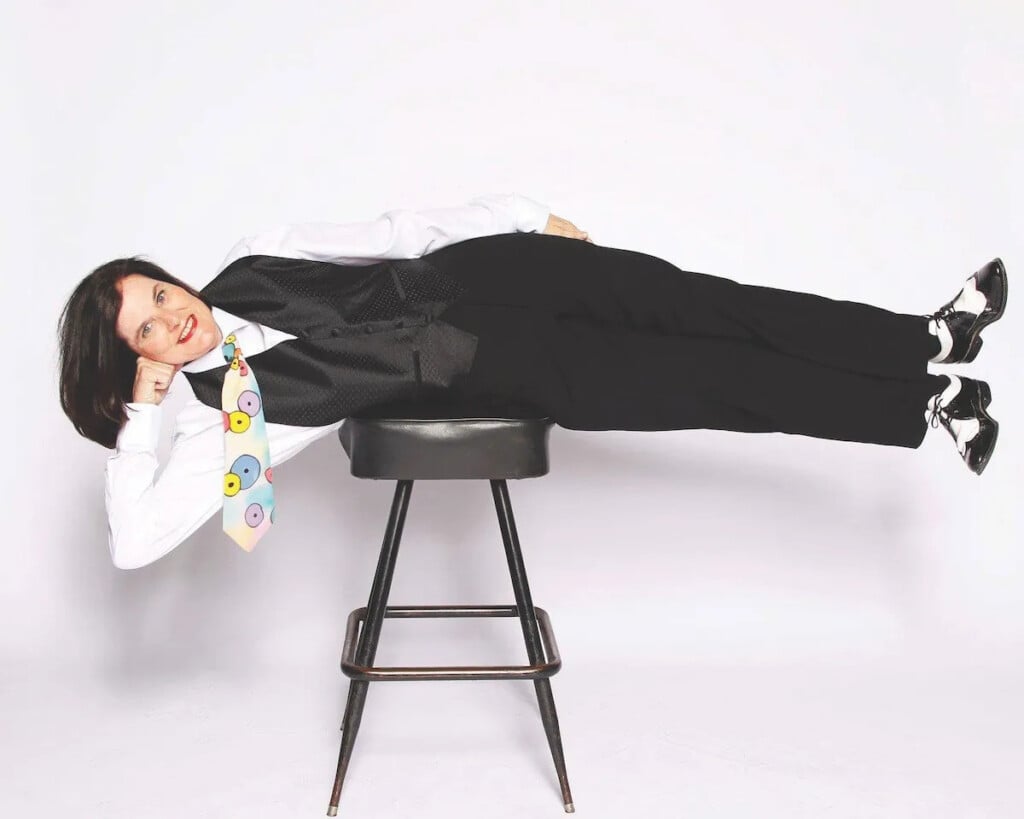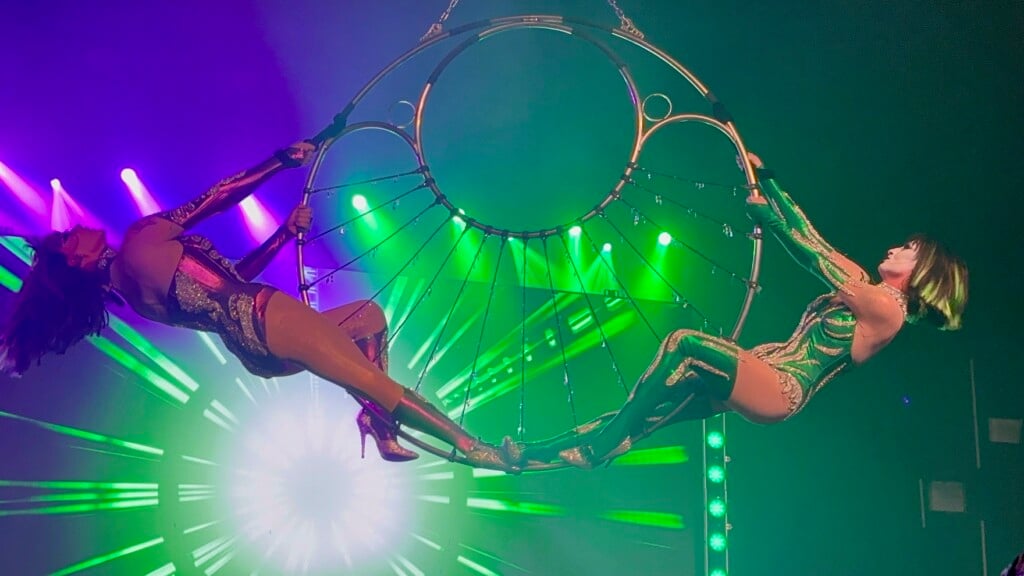Jekyll & Hyde ballet is a fabulous fright in North American premiere at the Kauffman Center

Kansas City Ballet Company Dancer Cameron Thomas as Mr. Hyde in Val Caniparoli’s Jekyll & Hyde. // photo by Brett Pruitt & East Market Studios
It’s fitting that KC Ballet began its 66th season on a Friday the 13th in October with Val Caniparoli’s Jekyll & Hyde, a rendition of the novel by Robert Louis Stevenson and its first premiere in North America.
In fact, Caniparoli began working with KC Ballet to bring his brainchild to life before the world premiere in Finland in 2020. He’s been working with the company’s music director, Ramona Pansegrau, for the last seven years on musical selections. The musical selection, performed by the KC Symphony, is simultaneously haunting and elegant, perfectly encapsulating the presentation of horror and ballet together.
The dancers of the KC Ballet company put on a flawless performance, with toe-breaking pirouettes, spins that defied the laws of physics, and movements that conveyed frightening sequences of events and portrayed a variety of emotions, from anguish, to desire, to terror.
In real life, when Robert Louis Stevenson wrote the book, he was dealing with chronic pain and using opiates to cope. The ballet is told as an opium-induced hallucination of Stevenson’s, with his journey in writing Jekyll & Hyde and Jekyll’s journey toward transitioning completely into Mr. Hyde unfolding side by side on stage, at times intertwining to the point it’s difficult to discern between them.
The story begins with Stevenson, played by Angelin Carrant, being ill in bed, his white pajamas and unkempt hair signaling this to the audience. From the start, the minor-led melodies set an eerie tone that reminds the audience that this isn’t a story with a happy ending.
He receives a dose of opium from a nurse through his arm, and as the opium takes effect, he becomes inspired to write the story. Stevenson’s jerky movements as this occurs mimic Dr. Jekyll’s as he turns into Mr. Hyde later in the ballet, showing how he is going through a transformation of his own—and Carrant manages to pull off these less-than-graceful maneuvers while still making them look like a dance.
Throughout the ballet, the color red appears repeatedly, and in many scenes, it is the only burst of color, whether it’s the stage lighting, clothing, or objects onstage. As red is symbolic of anger and violence, being the color of blood, it creates an ominous sensation and represents Hyde’s presence throughout the ballet.
From the beginning, when Jekyll first appears, played by Gavin Abercrombie, he is wearing a red vest and necktie, and red books and objects can be seen resting on the shelves and counters in his laboratory. These elements don’t just foreshadow the emergence of Mr. Hyde—they show that Hyde has always been there and always a part of Dr. Jekyll, waiting to be fully unleashed.
The use of color isn’t restricted to red, however. In the next scene, which takes place in Jekyll’s mental asylum, the dancers’ costumes are a sea of black, grey, and white, showing how it is a depressing place to be. This scene features the patients in a routine that isn’t quite synchronous or elegant—and it shouldn’t be, as it mirrors its setting.
After Jekyll takes the potion that is meant to bring out the subconscious side of himself, he is seen running through the dimly lit, foggy London streets, showing how he is and always has been running from Hyde. Hyde’s figure can be seen lurking in the shadows for a brief moment, which both Jekyll and Stevenson pick up on as Stevenson is seen receiving more opium.
The events of the first act set the stage for the second act, foreshadowing its events. Jekyll starts to drift down a morally grey path when he leaves a party thrown by his fiancée’s family to go to a tavern with his fiancée’s father, Sir Danvers Carew, and the other male guests. Here, the guests are engaging in raunchy behavior, with Carew dallying with scantily-dressed male prostitutes—foreshadowing how Hyde will lure him to his death with his charm in the second act. Carew, played by Christopher Ruud, draws the attention away from the main characters at the beginning of this scene, gracefully entrancing the prostitutes with pure sexual charisma—whether this was intentional or not, it’s hard to look away from a homoerotica being played out onstage in flashy, revealing Victorian-style attire.
Jekyll intervenes when the owner of the tavern behaves rudely toward a prostitute, Rowena—played by Amanda DeVenuta—who then becomes taken with Jekyll. Rowena’s playful purple gown presents a contrast to Jekyll’s more uptight and formal outfit. She brings out a different side of Jekyll than seen before, and they engage in a salacious dance that builds sexual tension between them thick enough to cut with a knife, with Jekyll tossing her in the air as he spins her around and then pulls her closer. But as Jekyll’s experimental drug starts to kick in, Rowena dons a red mask, symbolizing how Jekyll is starting to see the world as Hyde, and his behavior becomes increasingly aggressive. This foreshadows Rowena’s eventual fate in the second act.
Jekyll flees and races through the red door of his home. The audience holds their breath as they wait for Hyde to materialize onstage, and they’re not disappointed when he does. Cameron Thomas as Mr. Hyde waltzes toward the front of the stage, grinning menacingly, and his bow signals the end of the first act to an eruption of applause.
What’s interesting about Hyde’s appearance in the ballet is that he doesn’t have the ghastly appearance of the monsters we’re used to seeing; he’s devilishly handsome and put-together, showing that evil often masquerades as beauty. He’s wearing an all-black suit, minus an emblematic red tie, with a matching coat and hat—an upgrade from Jekyll’s costume that would be considered more casual by Victorian standards.
Without diving into the scene-by-scene, the second act details Hyde’s evil deeds and the horror of the other characters in reaction to his atrocities. Though Hyde does turn back into Jekyll at one point, he isn’t the same person he was before. He spirals further into delirium, ultimately taking the potion again to resume his villainy. Stevenson appears in the second act both in the background and as a direct part of the scenes to indicate his orchestration of these events through his writing of the story.
The score is heavier on the brass to distinguish the first act from the increasingly violent second act, with the musical highlights of the ballet occurring in the final sequences up to a climactic ending, where it serves to build the suspense between Jekyll and Hyde in their final semi-nude tango. Cameron Thomas as Hyde is simultaneously elegant and erratic, bringing together the complexities of Jekyll’s alter ego and demonstrating versatility as a ballet dancer. While he charms people as he meets them, they quickly become frightened of him as they realize he’s not who he appears to be.
The ballet wraps up with the same song it begins with, bringing both stories to an end and tying them together. Overwhelming applause filled the theatre at this conclusion, which left the audience to contemplate the overall themes of the story and how they apply to the rest of us.
This ballet isn’t on-the-edge-of-your-seat scary, but the suspense built through song and symbolism is enough to send shivers down your spine. Paired with a chilling score, the performance showcased some of the best talents of the KC Ballet Company and dispelled any prior misconceptions that ballet and horror don’t mix.
Jekyll & Hyde is at the Muriel Kauffman Center through Oct. 22, and more information and tickets can be found on KC Ballet’s website.






